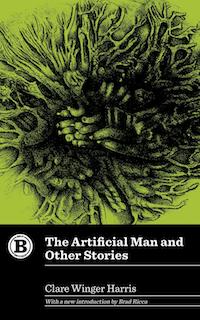 The Artificial Man and Other Stories
The Artificial Man and Other Stories
by
Clare Winger Harris
(Belt Publishing, February 2019, pb, 356 pp.)
Reviewed by Tara Grímravn
Although the first iterations of Women’s History Month date all the way back to 1911, it wasn’t until 1987 that Congress declared March to be the official period of observation in the United States. This celebration of women was later adopted in Canada, Australia, and the United Kingdom. It is fitting, then, that editor Brad Ricca chose to highlight the accomplishments of pioneering science-fiction author Claire Winger Harris (1891-1968) by putting together a new collection of her work in The Artificial Man and Other Stories. The book is set to be released on March 5, 2019, as part of Belt Publishing’s Revival series. Included between its covers are twelve stories in all, plus a letter Harris wrote to the editor of Wonder Stories, one of many pulp fiction magazines of the time that published science fiction.
Although Harris was a contemporary of authors like Isaac Asimov, William Faulkner, and Langston Hughes, if one were to mention her name in conversation today, it would likely garner little more than blank stares from most listeners. In truth, one could hardly blame them. Unlike Asimov, Faulkner, and Hughes, all of whom continued to publish into the 1960s or beyond, Harris only wrote for a mere seven years, from 1923 to 1930. Her all-too-brief career combined with the genre in which she wrote and the pulp fiction publications that published her have made her legacy slightly less visible.
One, then, might ask the question why a reprint of Claire Winger Harris’ work would be so apropos to Women’s History Month? The reasons are many.
To start, she holds the rather prestigious title of being the first woman to publish in the science fiction genre under her own name. The first story she ever published and the fourth story in this book is titled “The Fate of the Poseidonia.” It was the piece that launched her writing career. In 1923, she had submitted to a contest held by Amazing Stories, an SF pulp fiction magazine that was popular at the time, and her story won third place. Set in what was to Harris a futuristic version of 1955, it tells the tale of how Martians dealing with the catastrophic loss of their own water supply are able to drain off all of Earth’s oceans from right under humankind’s nose, taking along with them a few trophies, such as the ocean liner The Poseidonia. It so impressed Amazing Stories’ editor Hugo Gernsback that, not only did he speak highly of her when announcing the contest winners, he continued to regularly publish Harris’ stories.
Both winning this competition and receiving Gernsback’s praise was, in and of itself, a noteworthy accomplishment for the time. During the years in which Harris was actively writing, other women were also published in the genre but it was always done using a male pen name. Women were considered to be less adept at writing what was then known as scientifiction due to assumed differences in education and natural proclivities. As a result, editors feared that allowing a woman to publish under her own name might turn readers away. Harris, however, proved that this wasn’t the case at all. In fact, her stories became immensely popular.
Of course, being the first woman to publish under her own name isn’t Harris’ only contribution to the genre. “The Ape Cycle,” for example, may well be the inspiration behind the much-loved Planet of the Apes franchise and was first published in the May 1930 issue of Science Wonder. It tells the tale of Daniel Stoddart, who dreams of a world where apes are used as slaves in order to free humankind from the drudgery of work forever. Since human slavery is immoral, his work leads him and his son both towards developing various simian species into intelligent servants capable of speech. Unfortunately, the monkeys eventually revolt against their masters, led by a particularly intelligent specimen named Alpha.
Much to the gratitude of science fiction and DC Comics fans everywhere, Harris can also be credited for providing inspiration to the creators of the world’s most beloved Kryptonian, Superman. Three years after “The Ape Cycle” appeared in Science Wonder, Harris received a letter from Jerry Siegel and Joe Shuster, then just high school students, in 1933. In it, they expressed their love for her work and asked her to submit a story for their mimeographed magazine Science Fiction. She obliged and sent them “The Vibrometer.”
“The Vibrometer” is something of a lost tale, having only ever appeared in the teenaged duo’s hand-stapled magazine and now in The Artificial Man and Other Stories. It tells the story of a young physics teacher named Frank Rickard who has in his possession a machine that can amplify or decrease natural forces, rendering both seen and unseen spectrums invisible or visible respectively to the five senses at will. Upon showing the machine to three of his students, he gives them a demonstration that terrifies them as he disappears from view, only to reappear later with a wild story of his own.
The tales that appear in The Artificial Man and Other Stories are not new. In fact, they’re fast approaching a century old. Yet, much like Asimov, Claire Winger Harris’ stories possess something of the eternal. They aren’t perfect according to modern tastes, couched as they are in a style of prose that’s long since fallen out of favor, but they helped lay the foundation of the science fiction genre that we know today. And, much like the works of Isaac Asimov, they have retained their power to ignite the imagination. Fans of the genre, regardless of whether they are familiar with Harris, will most certainly enjoy this collection of short stories.